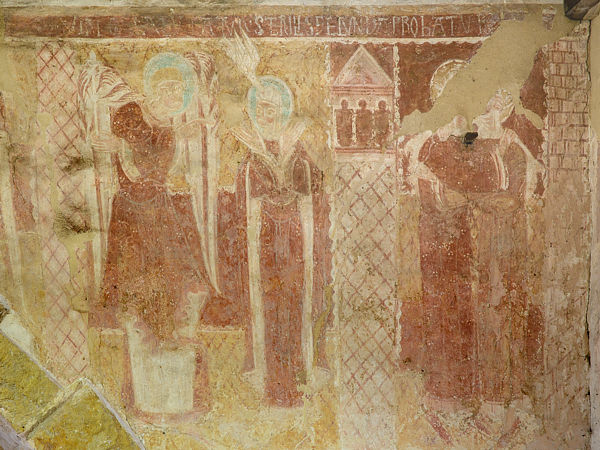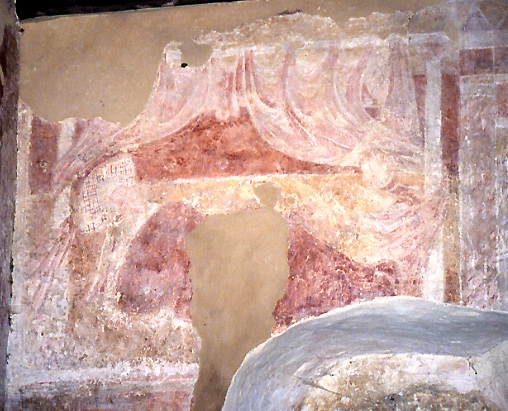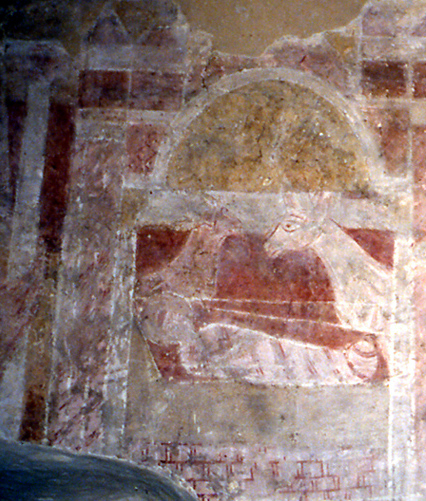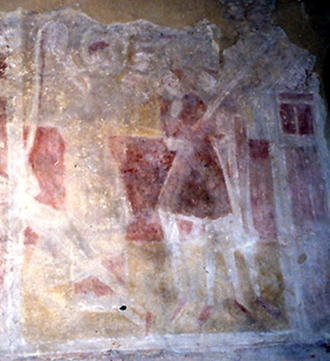Hardham, Sussex (†Chichester) C.12
The Annunciation and Visitation, The Nativity and Annunciation to the shepherds

The painted scheme at Hardham is probably the earliest yet found in Britain, and it seems to have been conceived as a unified whole from the start, illustrating Christian history from the Temptation and Fall of Man to the redemptive intervention by Christ The first two of these scenes, the Temptation and Fall in Eden, are painted in the chancel, and they have been on this site for some time. Not everything that follows in this painted Christological narrative is clear, but fortunately the next two scenes in chronological order, the Annunciation and Visitation, are among the clearest in the church, and they are shown here at the right. In the invaluable leaflet available in the church they are scenes 2 and 3, painted in the upper tier of the east wall of the nave and thus on the right, or south, side of the chancel arch.
At the left of the photograph, Gabriel, his left arm sweeping gracefully across his body as he bends in obeisance, stands facing Mary as she receives the Holy Spirit in the form of a dove hovering on her forehead in a similar way to the later example of this subject at Ashampstead. Mary’s hands are raised and held open on either side of her head, and both figures have haloes tinted blue.

At the right, Mary and her cousin Elizabeth embrace, their heads unfortunately obscured by damage to the painting in this area. An inscription in Lombardic capitals referring to Elizabeth’s supposed barrenness runs across the top of both scenes, and reads: VIRGO SALUTATUR STERILIS FECUNDA PROBATUR.
The narrative is taken up again on the south wall, with two scenes of the Nativity. The first (numbered 4 in the Hardham booklet) is shown below at the left. The boldness of the painter as he tackles the mystery of the Incarnation head-on is remarkable – The Virgin lies in bed at the right of this scene, her head identifiable by the fan-shaped and diapered cushion on which it rests. Improbable as a curtained four-poster bed in a stable would be, the curtains, blowing as if in a gale and wrapping themselves around the bedpost at the right may be of significance in the narrative. In the looped swag-like fold thus created, there is a hint – it is no more than that – of a very small head and face cradled there, as if wind, not for the first time in in Judeo-Christian scripture, were operating as an agent of the Holy Spirit. A possibility, no more; the detail is very faint, but I can see no reason to include the billowing curtains and the rushing wind they imply unless they are intended to carry meaning.

A more conventional Nativity scene (photo, below left) follows further right, showing the very tightly swaddled infant Christ in the rather coffin-like manger, with the Ox and Ass looking on.

Further along the south wall are more Nativity scenes. Some are clearer than others, and only the clearest are shown here. The next in order is the Annunciation to the Shepherds (numbered 5 in the Hardham booklet) shown here at the right. An angel, one of its typically narrow 12th century wings fairly clear, stands at the left, facing two shepherds who look upwards to the right, presumably at the star (not visible on the wall). A third shepherd has fallen onto one knee and peers beyond the frame at the lower left to look at the Christ Child.
The next scenes in order, starting with the Adoration of the Magi and including Joseph’s Dream, are now here, as are scenes from the Flight into Egypt up to the Baptism of Christ. Follow the links to see the relevant pages, which include the very rare Fall of the Idols, only the second example of this subject I have seen.
You can see a 360° panoramic tour of the interior of the church here.
Photo 1 © Roy Reed 2019